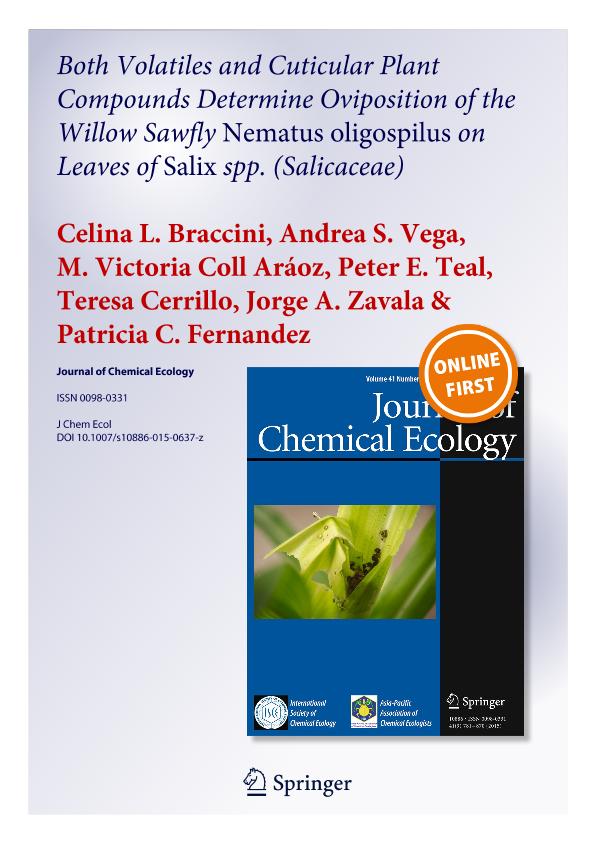Artículo
Both Volatiles and Cuticular Plant Compounds Determine Oviposition of the Willow Sawfly Nematus oligospilus on Leaves of Salix spp. (Salicaceae)
Braccini, Celina L.; Vega, Andrea Susana ; Coll Araoz, Maria Victoria
; Coll Araoz, Maria Victoria ; Teal, Peter E.; Cerrillo, Teresa; Zavala, Jorge Alberto
; Teal, Peter E.; Cerrillo, Teresa; Zavala, Jorge Alberto ; Fernandez, Patricia Carina
; Fernandez, Patricia Carina
 ; Coll Araoz, Maria Victoria
; Coll Araoz, Maria Victoria ; Teal, Peter E.; Cerrillo, Teresa; Zavala, Jorge Alberto
; Teal, Peter E.; Cerrillo, Teresa; Zavala, Jorge Alberto ; Fernandez, Patricia Carina
; Fernandez, Patricia Carina
Fecha de publicación:
10/2015
Editorial:
Springer
Revista:
Journal of Chemical Ecology
ISSN:
0098-0331
e-ISSN:
1573-1561
Idioma:
Inglés
Tipo de recurso:
Artículo publicado
Clasificación temática:
Resumen
Plant volatile organic compounds play a role in selection of host plants by herbivorous insects. Once the insect reaches the plant, contact cues determine host acceptance. Although the willow sawfly Nematus oligospilus (Hymenoptera: Tenthredinidae) can differentiate among willow genotypes, no knowledge is available on the cues used by this insect to seek and accept the host plant. In this study, we recorded behavioral orientation in a Y-tube olfactometer of willow sawfly females to volatiles of the highly preferred genotype Salix nigra and the non-preferred genotype S. viminalis. The volatiles released by undamaged willows of each genotype were analyzed by coupled gas chromatography-mass spectrometry. Contact cues were evaluated first by oviposition preference bioassays after selective leaf wax removal, and then by studying the micromorphology of abaxial and adaxial leaf surfaces and their chemical composition. Willow sawfly females oriented preferentially to S. nigra volatiles, which contained more than 3 times theamount of volatiles than that collected from S. viminalis. Analysis of volatiles showed significant differences in amounts of (Z) and (E)-β-ocimene, undecane, decanal, and β-caryophyllene. The adaxial leaf surface of S. nigra was less preferred after wax removal, suggesting a role of cuticular waxes for oviposition acceptance. No differences were found among the micromorphology of leaf surfaces between preferred and non-preferred genotypes. The chemical analysis of cuticular waxes showed that the abaxial leaf surface of S. viminalis, which is completely avoided for oviposition, possessed 97 % of alkanes. The accepted leaf surfaces contained a more diverse wax profile including alcohols, acids, and esters. Thus, non-alkane wax compounds might be related to oviposition. In sum, our study suggests that several cues act in concert to provide oviposition cues for the sawfly N. oligospilus: females are attracted to volatiles from a distance, and once alighting on the plant, they seek specific chemical contact cues in order to lay eggs.
Archivos asociados
Licencia
Identificadores
Colecciones
Articulos(SEDE CENTRAL)
Articulos de SEDE CENTRAL
Articulos de SEDE CENTRAL
Citación
Braccini, Celina L.; Vega, Andrea Susana; Coll Araoz, Maria Victoria; Teal, Peter E.; Cerrillo, Teresa; et al.; Both Volatiles and Cuticular Plant Compounds Determine Oviposition of the Willow Sawfly Nematus oligospilus on Leaves of Salix spp. (Salicaceae); Springer; Journal of Chemical Ecology; 41; 11; 10-2015; 985-996
Compartir
Altmétricas



